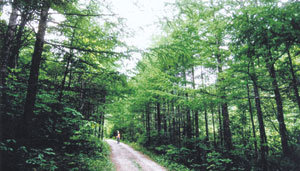Lets Bathe Together in That Green Forest
Lets Bathe Together in That Green Forest
Posted June. 13, 2004 22:25,

In a time of lacking medical technologies, a tuberculosis patient who is on the verge of death would stake his last hope on forests. Our ancestors once enjoyed therapeutic walks in the woods, and sometimes, miracles take place while patients recuperate with basking in forests.
Although we are in a time where cutting-edge medical technologies appear in high numbers, forests are full this time of year with people enjoying therapy there. This increased popularity of forest therapy is due to the so-called well-being syndrome, but what is the real temptation for these people?
▷There are healthful substances in forests
When a tree gets a cut, it automatically disinfects its wound by radiating a volatile substance called phytoncide. This is a compound word with phyton meaning plant and cide meaning killing.
Phytoncide is known to settle agitated nerve systems as well as aid sterilization. Does it have any medical foundation? As for this, there is room for argument because there are not many research results relevant to humans. However, the effects have proven to be positive in animal experiments.
Several years ago, in an experiment with mice carried out by the Korea Forest Research Institute and the Veterinary Research Center of Chungbuk University, Corticosteroid, a hormone that stimulates stress, increased in secretion when the research team gave an electric shock to a mouse. The research team then put the mouse into a box of phytoncide extracted from an aged pine tree, which calmed the animal.
There are more than a hundred kinds of phytoncide. Normally, coniferous trees contain a large amount of it, and the leaf has more than the stem. Terpene, the most representative substance, is a major ingredient in plant-scented perfume. With the recent popularity of well-being products, terpene is also widely used to make cosmetics, gum, liquor as an aromatic essence, and other fragrant substances.
▷The forest is a natural radiator of anion
Many people say that working out in the forest results in less fatigue than working out in the city. Although there is room for argument, herbal doctors and alternative medical therapists explain this to be the result of anion in forests. That is, anion reduces the positive ions released from the human body when one gets stressed.
Compared to cities, forests have more than 50 times the amount of anion. In particular, valleys and waterfalls where water molecules move actively have 70 to 80 times the amount of anion.
Tired feelings are not as noticeable in forests because they are full of cleaner oxygen than cities. Fatigue accumulated during workouts can be attributed to the insufficiency of oxygen. Although urban areas contain 10 million dust granules in one cubic meter, forests have only 500 to 2,000 granules in the same amount of space. In conclusion, abundant oxygen and anion protect ones psychological health.
▷In order to increase the forest therapy effect
Phytoncide is radiated most frequently from May to August. Therefore, right now is the most favorable time for forest therapy. Phytoncide is produced most in bright daylight, and from 10 a.m. to 12 p.m. is the ideal time of day.
The breast of a hill is the most suitable place for forest therapy. A location 60 to 100 meters within the inner side of a forest is good. Phytoncide is secreted more in older trees.
There is no specific way to participate in forest therapy. However, experts recommend walking just enough to break a sweat as one effective practice. When one rests, the perfumes of trees should be inhaled as deeply as possible.
Light clothes that are not too tight for ones body are best for forest therapy. Cotton clothes are best because they allow for efficient airing and proper sweat absorption. As for footwear, shoe soles should not be too slippery, and a hat with a visor is a good choice.
According to ancient Oriental medicine, if you beat your back with tree trunk, you can strengthen the intestine, because beating ones back stimulates the blood flow to the spinal column, which makes the human body sturdy.
(Assistance from: Professor Choi Han-seok of Ulsan University Medical Colleges Physiology Laboratory, Professor Song Young-ki of Seoul Asan Hospital Internal Secretion Department, Professor Lee Kyong-seop of Gangnam Kyunghee Oriental Medicine Hospital)
Sang Hoon Kim corekim@donga.com




![[단독]건보 가입자 40% 차지하는 2040세대, 병원 年 4회도 안 간다](https://dimg.donga.com/c/138/175/90/1/wps/NEWS/IMAGE/2025/12/21/133008933.1.jpg)


